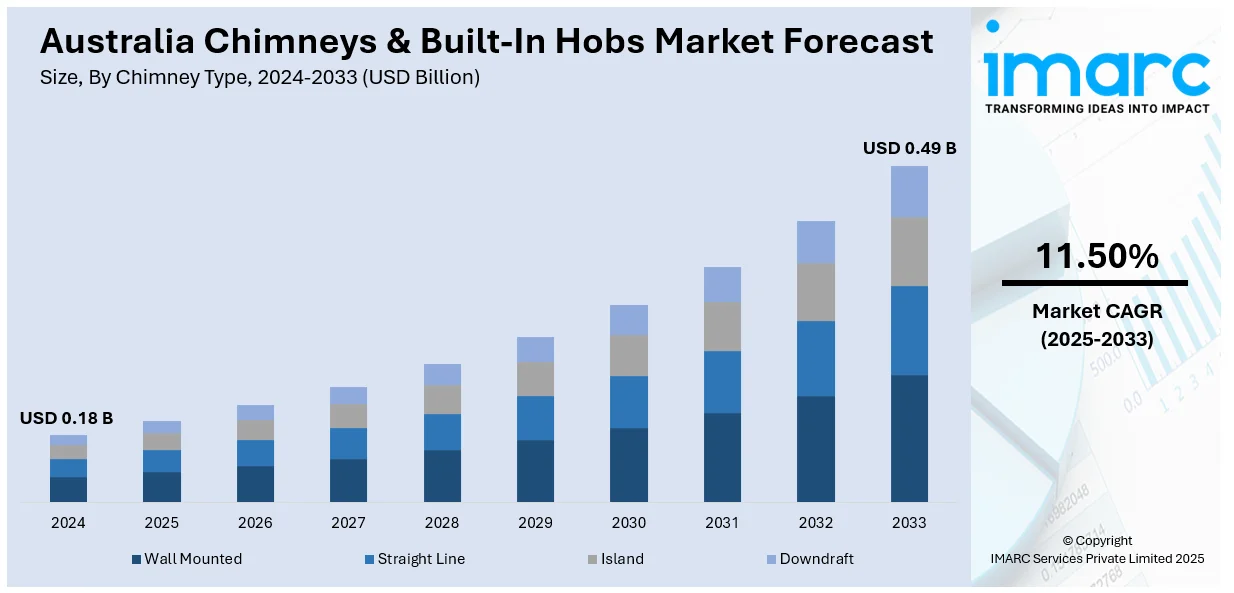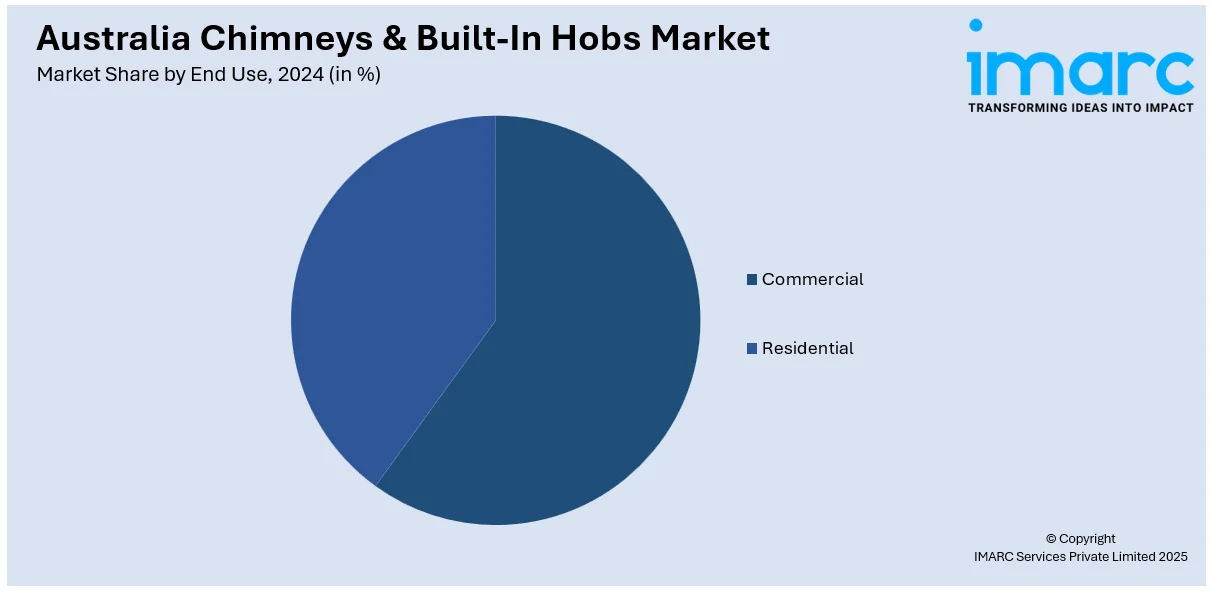
Australia Chimneys & Built-In Hobs Market Size, Share, Trends and Forecast by Chimney Type, Suction Power Range, Chimney Filter Type, Hood Type, Number of Burner, Stove Type, End Use, and Region, 2025-2033
Australia Chimneys & Built-In Hobs Market Overview:
The Australia chimneys & built-in hobs market size reached USD 0.18 Billion in 2024. Looking forward, IMARC Group expects the market to reach USD 0.49 Billion by 2033, exhibiting a growth rate (CAGR) of 11.50% during 2025-2033. The market is propelled by increasing demand for contemporary kitchen designs, integration of smart appliances, and energy-efficient technologies. Moreover, increased concern about the environment and rising interest in home refurbishment also contribute to market growth.
|
Report Attribute
|
Key Statistics
|
|---|---|
|
Base Year
|
2024
|
|
Forecast Years
|
2025-2033
|
|
Historical Years
|
2019-2024
|
| Market Size in 2024 | USD 0.18 Billion |
| Market Forecast in 2033 | USD 0.49 Billion |
| Market Growth Rate 2025-2033 | 11.50% |
Australia Chimneys & Built-In Hobs Market Trends:
Smart Integration and Technology Advancements
Smart technology advancements are aiding the expansion of the Australia chimneys & built-in hobs market share. Customers are now looking for appliances that ease their lives and deliver efficiency through a wide range of features like touchless controls, app connectivity, and smart sensors. A good example is an advanced kitchen chimney that, being IoT-enabled, allows users to monitor and control the appliance from afar, schedule cleaning cycles, and receive maintenance reminders. An integrated hob incorporates touch controls, automatic timers, and safety sensors to maximize user experience and cooking precision. Such innovations enable the latest functionality in kitchen appliances, aligned with an emerging trend toward smart home integration where consumers expect seamless connectivity and control of their home appliances. In light of this trend, manufacturers are also designing and innovating the product offerings to fulfill the changing demands of tech-savvy Australian consumers.

To get more information on this market, Request Sample
Energy Efficiency and Sustainability
Energy efficiency and sustainability are becoming major attributes influencing the Australia chimneys & built-in hobs market outlook. In 2023, temperature records were shattered in 77 countries around the globe. Australia was excluded from this group, as its yearly average temperature was 0.53°C lower than the dreadful year 2019. Temperatures in the oceans surrounding us fell below the levels recorded in 2022. Nonetheless, the revised Threatened Species Index indicates that the population of listed bird, mammal, and plant species has kept decreasing at roughly 3% annually since the beginning of the century. Due to which, environmental concerns and high electricity costs are major factors fueling the consumer shift toward energy-saving appliances at their homes. The replacement of conventional gas cooktops with induction-built hobs has thus, gained popularity, as they provide superior temperature control with reduced energy consumption. Moreover, kitchen chimneys with energy-efficient motors and LED lights are preferred owing to their low power consumption and long life. The market is responding, in turn, with products that are energy-efficient and contain green materials and sustainable design elements. The emphasis on energy efficiency and sustainability in appliances is part of a larger shift among consumers to make environmentally friendly purchases, which has a significant impact on the Australian market's product availability.
Aesthetic Appeal and Customization
Aesthetic value and personalization are influencing consumer choices, which in turn is contributing to the Australia chimneys & built-in hobs market growth. With the kitchen arena becoming a center of attention for home design and socializing, homeowners desire appliances that match their interior aesthetic and taste. Built-in hobs are favored for their sleek, integrated appearance, offering a modern and streamlined look that creates a harmonious kitchen design. Similarly, kitchen chimneys too, are available in varied styles, finishes, and sizes, so that buyers can select versions suitable to the look of their kitchens and preferences. Similarly, firms are offering customization options, such as modular versions and inter-changeable panels, to suit personal tastes and space requirements. Such an emphasis on design and customization is part of a broader movement where functionality and beauty complement each other.
Australia Chimneys & Built-In Hobs Market Segmentation:
IMARC Group provides an analysis of the key trends in each segment of the market, along with forecasts at the country and regional levels for 2025-2033. Our report has categorized the market based on chimney type, suction power range, chimney filter type, hood type, number of burner, stove type, and end use.
Chimney Type Insights:
- Wall Mounted
- Straight Line
- Island
- Downdraft
The report has provided a detailed breakup and analysis of the market based on the chimney type. This includes wall mounted, straight line, island, and downdraft.
Suction Power Range Insights:
- Below 1,000 m3/hr
- 1,000-1,500 m3/hr
- Above 1,500 m3/hr
The report has provided a detailed breakup and analysis of the market based on the suction power range. This includes below 1,000 m3/hr, 1,000-1,500 m3/hr, and above 1,500 m3/hr.
Chimney Filter Type Insights:
- Baffle Filter
- Mesh Filter
- Charcoal Filter
The report has provided a detailed breakup and analysis of the market based on the chimney filter type. This includes baffle filter, mesh filter, and charcoal filter.
Hood Type Insights:
- Ducted Hood
- Ductless Hood
A detailed breakup and analysis of the market based on the hood type has also been provided in the report. This includes ducted hood and ductless hood.
Number of Burner Insights:
- 1-2 Burners
- 3-4 Burners
- More than 4 Burners
A detailed breakup and analysis of the market based on the number of burner has also been provided in the report. This includes 1-2 burners, 3-4 burners, and more than 4 burners.
Stove Type Insights:
- Gas Hob
- Induction Hob
- Hybrid
- Electric Plate
A detailed breakup and analysis of the market based on the stove type has also been provided in the report. This includes gas hob, induction hob, hybrid, and electric plate
End Use Insights:

- Residential
- Commercial
A detailed breakup and analysis of the market based on the end use has also been provided in the report. This includes residential and commercial.
Regional Insights:
- Australia Capital Territory & New South Wales
- Victoria & Tasmania
- Queensland
- Northern Territory & Southern Australia
- Western Australia
The report has also provided a comprehensive analysis of all the major regional markets, which include Australia Capital Territory & New South Wales, Victoria & Tasmania, Queensland, Northern Territory & Southern Australia, and Western Australia.
Competitive Landscape:
The market research report has also provided a comprehensive analysis of the competitive landscape. Competitive analysis such as market structure, key player positioning, top winning strategies, competitive dashboard, and company evaluation quadrant has been covered in the report. Also, detailed profiles of all major companies have been provided.
Australia Chimneys & Built-In Hobs Market Report Coverage:
| Report Features | Details |
|---|---|
| Base Year of the Analysis | 2024 |
| Historical Period | 2019-2024 |
| Forecast Period | 2025-2033 |
| Units | Billion USD |
| Scope of the Report |
Exploration of Historical Trends and Market Outlook, Industry Catalysts and Challenges, Segment-Wise Historical and Future Market Assessment:
|
| Chimney Types Covered | Wall Mounted, Straight Line, Island, Downdraft |
| Suction Power Ranges Covered | Below 1,000 m3/hr, 1,000-1,500 m3/hr, Above 1,500 m3/hr |
| Chimney Filter Types Covered | Baffle Filter, Mesh Filter, Charcoal Filter |
| Hood Types Covered | Ducted Hood, Ductless Hood |
| Number of Burners Covered | 1-2 Burners, 3-4 Burners, More than 4 Burners |
| Stove Types Covered | Gas Hob, Induction Hob, Hybrid, Electric Plate |
| End Uses Covered | Residential, Commercial |
| Regions Covered | Australia Capital Territory & New South Wales, Victoria & Tasmania, Queensland, Northern Territory & Southern Australia, Western Australia |
| Customization Scope | 10% Free Customization |
| Post-Sale Analyst Support | 10-12 Weeks |
| Delivery Format | PDF and Excel through Email (We can also provide the editable version of the report in PPT/Word format on special request) |
Key Questions Answered in This Report:
- How has the Australia chimneys & built-in hobs market performed so far and how will it perform in the coming years?
- What is the breakup of the Australia chimneys & built-in hobs market on the basis of chimney type?
- What is the breakup of the Australia chimneys & built-in hobs market on the basis of suction power range?
- What is the breakup of the Australia chimneys & built-in hobs market on the basis of chimney filter type?
- What is the breakup of the Australia chimneys & built-in hobs market on the basis of hood type?
- What is the breakup of the Australia chimneys & built-in hobs market on the basis of number of burner?
- What is the breakup of the Australia chimneys & built-in hobs market on the basis of stove type?
- What is the breakup of the Australia chimneys & built-in hobs market on the basis of end use?
- What is the breakup of the Australia chimneys & built-in hobs market on the basis of region?
- What are the various stages in the value chain of the Australia chimneys & built-in hobs market?
- What are the key driving factors and challenges in the Australia chimneys & built-in hobs market?
- What is the structure of the Australia chimneys & built-in hobs market and who are the key players?
- What is the degree of competition in the Australia chimneys & built-in hobs market?
Key Benefits for Stakeholders:
- IMARC’s industry report offers a comprehensive quantitative analysis of various market segments, historical and current market trends, market forecasts, and dynamics of the Australia chimneys & built-in hobs market from 2019-2033.
- The research report provides the latest information on the market drivers, challenges, and opportunities in the Australia chimneys & built-in hobs market.
- Porter's five forces analysis assist stakeholders in assessing the impact of new entrants, competitive rivalry, supplier power, buyer power, and the threat of substitution. It helps stakeholders to analyze the level of competition within the Australia chimneys & built-in hobs industry and its attractiveness.
- Competitive landscape allows stakeholders to understand their competitive environment and provides an insight into the current positions of key players in the market.
Need more help?
- Speak to our experienced analysts for insights on the current market scenarios.
- Include additional segments and countries to customize the report as per your requirement.
- Gain an unparalleled competitive advantage in your domain by understanding how to utilize the report and positively impacting your operations and revenue.
- For further assistance, please connect with our analysts.
 Request Customization
Request Customization
 Speak to an Analyst
Speak to an Analyst
 Request Brochure
Request Brochure
 Inquire Before Buying
Inquire Before Buying




.webp)




.webp)












